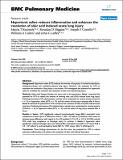| dc.contributor.author | Kennedy, Muiris T | en |
| dc.contributor.author | Higgins, Brendan D | en |
| dc.contributor.author | Costello, Joseph F | en |
| dc.contributor.author | Curtin, William A | en |
| dc.contributor.author | Laffey, John G | en |
| dc.date.accessioned | 2010-10-13T16:14:45Z | en |
| dc.date.available | 2010-10-13T16:14:45Z | en |
| dc.date.issued | 2008-07-08 | en |
| dc.identifier.citation | Kennedy M.T., Higgins B.D., Costello J.F., Curtin W.A. & Laffey J.G. (2008) Hypertonic saline reduces inflammation and enhances the resolution of oleic acid induced acute lung injury.,BMC Pulm Med. 2008; 8: 9. | en |
| dc.identifier.issn | 1471-2466 | en |
| dc.identifier.uri | http://hdl.handle.net/10379/1330 | en |
| dc.description.abstract | Background:
Hypertonic saline (HTS) reduces the severity of lung injury in ischemia-reperfusion, endotoxin-induced and ventilation-induced lung injury. However, the potential for HTS to modulate the resolution of lung injury is not known. We investigated the potential for hypertonic saline to modulate the evolution and resolution of oleic acid induced lung injury.
Methods:
Adult male Sprague Dawley rats were used in all experiments. Series 1 examined the potential for HTS to reduce the severity of evolving oleic acid (OA) induced acute lung injury. Following intravenous OA administration, animals were randomized to receive isotonic (Control, n = 12) or hypertonic saline (HTS, n = 12), and the extent of lung injury assessed after 6 hours. Series 2 examined the potential for HTS to enhance the resolution of oleic acid (OA) induced acute lung injury. Following intravenous OA administration, animals were randomized to receive isotonic (Control, n = 6) or hypertonic saline (HTS, n = 6), and the extent of lung injury assessed after 6 hours.
Results :
In Series I, HTS significantly reduced bronchoalveolar lavage (BAL) neutrophil count compared to Control [61.5 ± 9.08 versus 102.6 ± 11.89 × 103 cells.ml-1]. However, there were no between group differences with regard to: A-a O2 gradient [11.9 ± 0.5 vs. 12.0 ± 0.5 KPa]; arterial PO2; static lung compliance, or histologic injury. In contrast, in Series 2, hypertonic saline significantly reduced histologic injury and reduced BAL neutrophil count [24.5 ± 5.9 versus 46.8 ± 4.4 × 103 cells.ml-1], and interleukin-6 levels [681.9 ± 190.4 versus 1365.7 ± 246.8 pg.ml-1].
Conclusion:
These findings demonstrate, for the first time, the potential for HTS to reduce pulmonary inflammation and enhance the resolution of oleic acid induced lung injury. | en |
| dc.format | application/pdf | en |
| dc.language.iso | en | en |
| dc.publisher | BioMed Central Ltd. | en |
| dc.rights | Attribution-NonCommercial-NoDerivs 3.0 Ireland | |
| dc.rights.uri | https://creativecommons.org/licenses/by-nc-nd/3.0/ie/ | |
| dc.subject | Pulmonary medicine | en |
| dc.subject | National Centre for Biomedical Engineering Science | en |
| dc.subject | NCBES | en |
| dc.title | Hypertonic saline reduces inflammation and enhances the resolution of oleic acid induced acute lung injury | en |
| dc.type | Article | en |
| dc.local.publishedsource | http://www.ncbi.nlm.nih.gov/pmc/articles/PMC2467400/ | en |
| dc.description.peer-reviewed | peer-reviewed | en |
| dc.contributor.funder | Millennium Research Fund, NUI Galway | en |
| dc.contributor.funder | Yamanouchi European Research Foundation | en |
| nui.item.downloads | 448 | |


